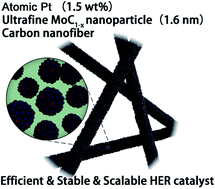Atom-precise incorporation of platinum into ultrafine transition metal carbides for efficient synergetic electrochemical hydrogen evolution†
Abstract
Exploring highly efficient and stable electrocatalysts for the hydrogen evolution reaction (HER) has captured widespread attention. Atomic engineering of material structures paves a powerful pathway to develop advanced electrocatalysts by virtue of precisely modulating the reactivity and maximizing the atomic efficiency, although it still stands as a big challenge. In this work, a new method of multiple molecular level confinement is proposed to in situ incorporate atomic platinum (1.5 wt%) into ultrafine transition metal carbides through electrospinning and pyrolysis. The hybrid catalyst exhibits superior electrocatalytic performance towards the HER in acidic medium in terms of overpotential (38 mV at 10 mA cm−2), Tafel slope (27 mV dec−1), mass activity (3.49 A mg−1) and stability (10 mV decay after 5000 CV cycles). Detailed investigation reveals that the excellent performance is mainly attributed to the electronic modulation of atomic Pt over α-MoC1−x and highly exposed active sites originating from atomic and ultrafine properties. The generality of this method is further demonstrated with a Pt-doped ultrafine WCx catalyst. This work elucidates a facile strategy to design efficient electrocatalysts via atomic nanostructure and composition engineering, shedding light on the exploration and optimization of hybrid catalysts.



 Please wait while we load your content...
Please wait while we load your content...